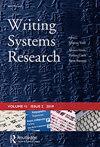Txting across time: undergraduates’ use of ‘textese’ in seven consecutive first-year psychology cohorts
Q1 Arts and Humanities
引用次数: 10
Abstract
ABSTRACT Communicating by text message is an everyday occurrence for most young adults. This form of communication is often associated with an abbreviated, unconventional spelling style, sometimes called ‘textese’. In this study, we report on the changing written language of text messaging, across seven cohorts of first-year Psychology undergraduates (n = 728) at an Australian university. From 2009 to 2015, the decline of textese use has gradually tailed off, but remains to represent approximately 12% of written words. Earlier attempts to reduce the number of characters (e.g., for ) are now equalled by emotionally expressive spellings that increase the number of characters (e.g., ), and women have continued to use more textese than men. It appears that today’s larger phone screens and keyboards, and easier input methods, rather than any changes in views on the appropriateness of using textese, are the main drivers in reducing young adults’ tendency to use unconventional spellings in their text messages.跨时间发短信:连续7个心理学新生队列中大学生使用“短信”的情况
对大多数年轻人来说,发短信是家常便饭。这种交流方式通常与一种缩写的、非常规的拼写风格有关,有时被称为“textese”。在这项研究中,我们报告了澳大利亚一所大学的七组心理学一年级本科生(n = 728)的短信书写语言的变化。从2009年到2015年,文本使用的下降趋势逐渐减弱,但仍占书面词汇的12%左右。早期减少字符数量的尝试(例如,for)现在等同于增加字符数量的情感表达拼写(例如,),并且女性继续比男性更多地使用文本。看来,如今更大的手机屏幕和键盘以及更便捷的输入法,而不是人们对使用文本的恰当性的看法发生了任何变化,是年轻人在短信中使用非常规拼写的倾向减少的主要原因。
本文章由计算机程序翻译,如有差异,请以英文原文为准。
求助全文
约1分钟内获得全文
求助全文

 求助内容:
求助内容: 应助结果提醒方式:
应助结果提醒方式:


